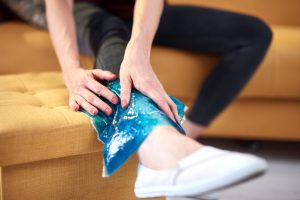
Is the RICE Method Actually Helpful for Acute Injuries?
Treatment Guidelines"Coaches have used my RICE guideline for decades, but now it appears that both ice and complete rest may delay healing, instead of helping.” What exactly does the new evidence say? Let’s evaluate this technique step by step with the latest research.
The RICE method has been the go-to for many patients and clinicians since the ’70s. When a friend rolls their ankle, a patient comes in after a sprain, or you trip and fall yourself, what do you often first recommend? “Just put some ice on it.” A widespread technique, Rest, Ice, Compression, and Elevation, is touted as a cure-all for any form of injury. Everyone from athletic trainers to pediatricians to sports rehab clinics recommend it. But is it really that effective?
Initially coined by Dr. Gabe Mirkin in the 1978 “Sports Medicine Book”, the RICE method is recommended to improve recovery. But in 2015, Dr. Mirkin published a dramatic turn-around. “When I wrote my best-selling Sportsmedicine Book in 1978, I coined the term RICE (Rest, Ice, Compression, Elevation) for the treatment of athletic injuries,” he wrote 1. “Ice has been a standard treatment for injuries and sore muscles because it helps relieve pain caused by injured tissue. Coaches have used my “RICE” guideline for decades, but now it appears that both Ice and complete Rest may delay healing, instead of helping.”
So what does the evidence say? Is the RICE method still evidence-based treatment, or should we adjust our recommendations? Let’s evaluate this technique step by step with the latest research.
Rest
Starting with Rest, Dr. Mirkin recommended this to decrease blood flow and allow the tissue to recover. By reducing the metabolic demands on the area, the healing process could avoid interruption caused by movement. The “fragile” healing process would be allowed to continue without difficulty. However, research shows that rest can actually harm recovery.
Research2 has shown that rest can complicate the healing process and increase pain levels. In multiple studies3, the longer a joint remains immobilized, the more difficult it is to begin moving again. In some studies, contractures formed due to immobilization, and tissue began atrophy.
Although the primary goal of resting was to facilitate the healing process, immobilizing an injury can prevent lymphatic drainage. All of the “waste” products created during healing need eliminating, and rest can disturb natural lymph circulation. In addition, rest may increase sensitivity to pain and movement 3, leading to more pain even long after the injury.
In contrast, experts note4 that active recovery “improves blood flow, which brings oxygen and removes metabolic waste” from the injured area. The general consensus is that in most cases, rest is only beneficial immediately after injury. This rest is best limited to short durations.
Ice
Next is Ice. “Healing requires inflammation.” So explains Dr. Mirkin in his writing that defines the limitations of the RICE method1. As the immune system rushes to repair tissue damage, blood vessels widen to increase blood flow to the area 5. As the blood rushes to the injury site, white blood cells rush to repair tissue damage and initiate recovery.
Although ice may feel soothing, it constricts the blood vessels that would provide fresh, oxygenated blood to the area. Studies5 show that this vasoconstriction lasts long after applying ice. In fact, it can decrease the white blood cells and oxygen delivered to the site.
Without these healing elements, a lack of white blood cells can significantly delay tissue regeneration and recovery. Even worse, some studies have linked tissue death and nerve damage. Notwithstanding these severe implications, icing can also increase swelling and pain. Long-term ice application shows no benefit and perhaps mostly detrimental results.
The use of ice in pain management is a different story. Many studies show possible benefits in intermittent ice application for short-term periods of about 10 minutes. These benefits are most often seen shortly after injury when there is significant time between applications. Many recommend applying ice for no more than 10 minutes and removing it for 20 or more before reapplying. As Dr. Mirkin said, “there is no reason to apply ice more than six hours after” injury.
Compression
Compression also was advocated as a method to decrease swelling of the injured site. According to prior thinking, compression would limit the amount of scar tissue and extra fluid in the injury. However, the body’s natural healing process requires some inflammation to occur. Therefore, methods to prevent this natural swelling process can cause more harm than good.
Interestingly, most studies show no sure benefits from compression after injury 5. As a result, experts have a hard time making any consistent recommendations. One study explains, “Based on our review, evidence… to support the use of compression…is limited. No information can be provided about the best way, amount, and duration of compression or the position in which the compression treatment is given.”6
Some experts have suggested that compression provides the most significant benefits through the placebo effect. Some have recommended compression specifically when a patient feels there will be a benefit4.
Elevation
Finally, elevation. Like compression, elevation came from a common-sense approach. If the swelling occurs in a distal limb, raising it will pump the blood back to the heart. However, since we know that the increased blood flow will expedite healing, why are we working so hard to prevent it?
Although there is little to no research to validate the use of elevation, there also isn’t any evidence that warns against it6. Elevation seems to provide a solid placebo-effect reassurance to some patients, which may bring a benefit. In certain instances, elevation may be warranted, and even an automatic reaction 7.
Conclusion
So if the RICE method isn’t the go-to anymore, what is the new standard for acute injury recovery? Unfortunately, there may not be one just yet. A variety of suggestions for acronyms have surfaced. One method advocates that we MOVE: Movement (not rest), Options for cross-training and treatment are provided, Vary rehabilitation with strength, balance, and agility drills, and Ease back into activity early for improved emotional stability 4. This doesn’t have the same quick-fix appeal as RICE, though, and leaves some aspects vague.
Another proposed method is POLICE: Protection, Optimal Loading, Ice (for analgesic purposes), Compression, and Elevation.8 Some of these steps, however, lack evidence-based backing, such as compression and elevation.
Ultimately, there is no quick fix for acute injury. Treatment protocols should be based on the individual and their injury, not instituted as a blanket solution. Trained professionals have the fundamental knowledge needed to provide recommendations, and the patient and the clinician should weigh the benefits and risks of each treatment. Each patient and problem is different, and it’s our job to provide them with the care they need.
Sydney Moninger, COTA/L is an Occupational Therapy Assistant and freelance writer. She has more than 10 years of clinical experience working in pediatric, orthopedic, and geriatric settings. Most recently, she has been helping patients at a pain management center for orthopedic injuries. Sydney is passionate about patient education and increasing health literacy in the community, which is what got her started in her writing in the first place. She loves discovering new perspectives that improve her clinical practice, and connecting with others on LinkedIn or her Upwork page.
References
- Mirkin, G. 2015. “Why Ice Delays Recovery”. DrMirkin.com. https://www.drmirkin.com/fitness/why-ice-delays-recovery.html
- Mehlhoff, T. 1988. NCBI. “Simple dislocation of the elbow in the adult. Results after closed treatment”. https://pubmed.ncbi.nlm.nih.gov/3343270/
- Gerber, E. 2018. University of Delaware. “RICE may not be all it’s cooked up to be for injury rehabilitation…”. https://sites.udel.edu/coe-engex/2018/02/21/r-i-c-e-may-not-be-all-its-cooked-up-to-be-for-injury-rehabilitation/
- Robinson, J. 2017. “MOVE an injury not RICE”. University of British Columbia.
- Scialoa, D. 2020. The Sport Journal. “The R.I.C.E. Protocol is a MYTH: A Review and Recommendations”. https://thesportjournal.org/article/the-r-i-c-e-protocol-is-a-myth-a-review-and-recommendations/
- PJ van der Bekerom, M. 2012. Journal of Athletic Training. “What is the Evidence for Rest, Ice, Compression, and Elevation Therapy in the Treatment of Ankle Sprains in Adults?” https://www.ncbi.nlm.nih.gov/pmc/articles/PMC3396304/https://www.ncbi.nlm.nih.gov/pmc/articles/PMC3396304/
- Dellwo, A. 2021. VeryWell Health. “RICE Method Benefits and Side Effects: Is There a Better Option?” https://www.verywellhealth.com/why-you-shouldnt-do-rice-for-sprains-4144771
- Bleakley, C. M. 2012. British Journal of Sports Medicine. “PRICE Needs Updating, Should we Call the Police?” https://bjsm.bmj.com/content/46/4/220





